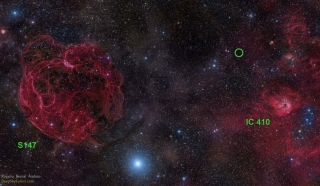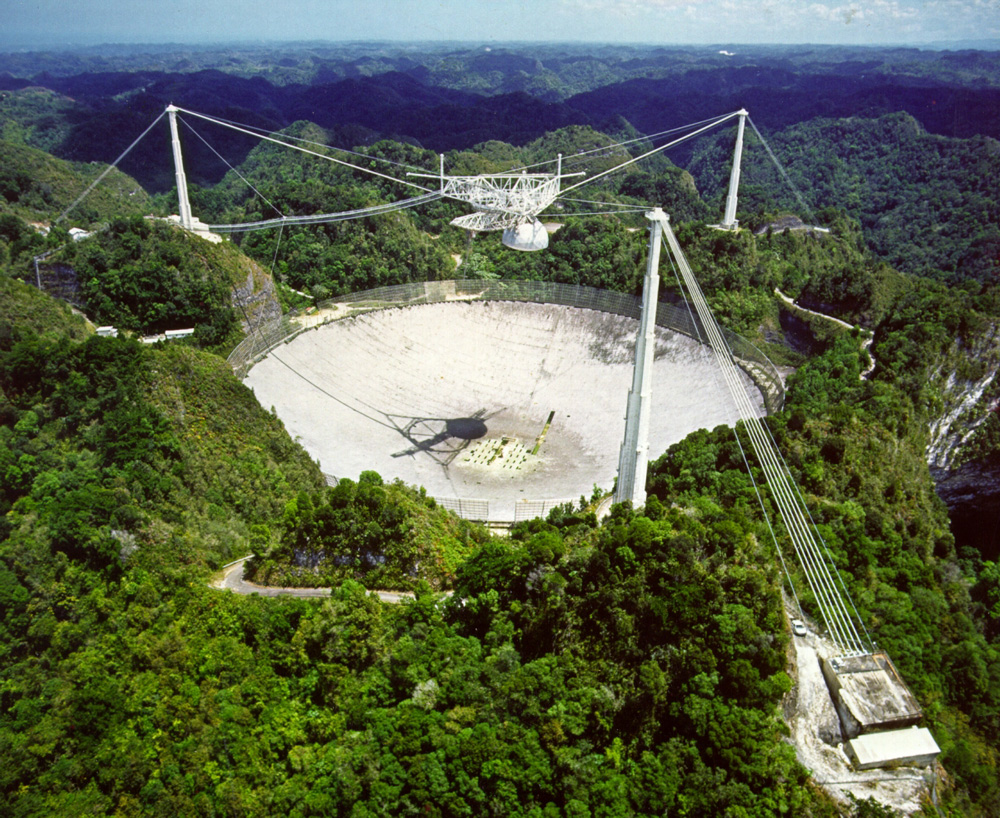Arecibo detects mystery radio burst from beyond our galaxy
July 11, 2014

Optical sky image of the area in the constellation Auriga where the fast radio burst FRB 121102 has been detected. The position of the burst, between the old supernova remnant S147 (left) and the star formation region IC 410 (right) is marked with a green circle. The burst appears to originate from much deeper in space, far beyond our galaxy. (Credit: Rogelio Bernal Andreo (DeepSkyColors.com))
Scientists have discovered a split-second burst of radio waves using the Arecibo radio telescope in Puerto Rico, published July 10 in The Astrophysical Journal.
The finding marks the first time that a “fast radio burst” has been detected using an instrument other than the Parkes radio telescope in Australia.
Scientists using the Parkes Observatory have recorded a handful of such events, but the lack of any similar findings by other facilities had led to speculation that the Australian instrument might have been picking up signals originating from sources on or near Earth.
“Our result is important because it eliminates any doubt that these radio bursts are truly of cosmic origin,” said Victoria Kaspi, an astrophysics professor at McGill University in Montreal and Principal Investigator for the pulsar-survey project that detected this fast radio burst. “The radio waves show every sign of having come from far outside our galaxy — a really exciting prospect.”
Unknown source
Exactly what may be causing such radio bursts represents a major new enigma for astrophysicists. Possibilities include a range of exotic astrophysical objects, such as evaporating black holes, mergers of neutron stars, or flares from magnetars — a type of neutron star with extremely powerful magnetic fields.

Arecibo Observatory (credit: NAIC-Arecibo Observatory)
“Another possibility is that they are bursts much brighter than the giant pulses seen from some pulsars,” notes James Cordes, a professor of astronomy at Cornell University and co-author of the new study.
The unusual pulse was detected on Nov. 2, 2012, at the Arecibo Observatory, a National Science Foundation-sponsored facility that boasts the world’s largest and most sensitive radio telescope, with a radio-mirror dish spanning 305 metres and covering about 20 acres.
While fast radio bursts last just a few thousandths of a second and have rarely been detected, the international team of scientists reporting the Arecibo finding confirm previous estimates that these strange cosmic bursts occur roughly 10,000 times a day over the whole sky. This astonishingly large number is inferred by calculating how much sky was observed, and for how long, in order to make the few detections that have so far been reported.
“The brightness and duration of this event, and the inferred rate at which these bursts occur, are all consistent with the properties of the bursts previously detected by the Parkes telescope in Australia,” said Laura Spitler, lead author of the new paper, who first noted the event. Spitler, now a postdoctoral researcher at the Max Planck Institute for Radio Astronomy in Bonn, Germany, was a PhD student at Cornell when the research work began.

Plots of FRB 121102 showing signal/noise ratio as a function of time and frequency. In each panel, the data were smoothed in time and frequency by a factor of 30 and 10, respectively. (Credit: L.G. Spitler et al./The Astrophysical Journal)
The bursts appear to be coming from beyond the Milky Way galaxy based on measurement of an effect known as plasma dispersion. Pulses that travel through the cosmos are distinguished from man-made interference by the effect of interstellar electrons, which cause radio waves to travel more slowly at lower radio frequencies. The burst detected by the Arecibo telescope has three times the maximum dispersion measure that would be expected from a source within the galaxy, the scientists report.
The discovery was made as part of the Pulsar Arecibo L-Band Feed Array (PALFA) survey, which aims to find a large sample of pulsars and to discover rare objects useful for probing fundamental aspects of neutron star physics and testing theories of gravitational physics.
Efforts are now under way to detect radio bursts using radio telescopes that can observe broad swaths of the sky to help identify them. Telescopes under construction in Australia and South Africa as well as the CHIME telescope in Canada have the potential to detect fast radio bursts; astronomers say these and other new facilities could pave the way for many more discoveries and a better understanding of this mysterious cosmic phenomenon.
The research was supported by grants from the European Research Council, the National Science Foundation, the Natural Sciences and Engineering Research Council of Canada, the Fonds de recherche du Québec – Nature et technologies, and the Canadian Institute for Advanced Research, among others. Prof. Kaspi is the R. Howard Webster Foundation Fellow of CIFAR’s Cosmology & Gravity program; she also holds the Lorne Trottier Chair in Astrophysics and Cosmology as well as a Canada Research Chair at McGill.
The Arecibo Observatory is operated by SRI International in alliance with Ana G. Méndez-Universidad Metropolitana and the Universities Space Research Association, under a cooperative agreement with the National Science Foundation (AST-1100968). The data were processed on the ATLAS cluster of the Max Planck Institute for Gravitational Physics (Albert Einstein Institute), Hannover, Germany.
Abstract of The Astrophysical Journal paper
Recent work has exploited pulsar survey data to identify temporally isolated, millisecond-duration radio bursts with large dispersion measures (DMs). These bursts have been interpreted as arising from a population of extragalactic sources, in which case they would provide unprecedented opportunities for probing the intergalactic medium; they may also be linked to new source classes. Until now, however, all so-called fast radio bursts (FRBs) have been detected with the Parkes radio telescope and its 13-beam receiver, casting some concern about the astrophysical nature of these signals. Here we present FRB 121102, the first FRB discovery from a geographic location other than Parkes. FRB 121102 was found in the Galactic anti-center region in the 1.4 GHz Pulsar Arecibo L-band Feed Array (ALFA) survey with the Arecibo Observatory with a DM = 557.4 ± 2.0 pc cm–3, pulse width of 3.0 ± 0.5 ms, and no evidence of interstellar scattering. The observed delay of the signal arrival time with frequency agrees precisely with the expectation of dispersion through an ionized medium. Despite its low Galactic latitude (b = –0![]() 2), the burst has three times the maximum Galactic DM expected along this particular line of sight, suggesting an extragalactic origin. A peculiar aspect of the signal is an inverted spectrum; we interpret this as a consequence of being detected in a sidelobe of the ALFA receiver. FRB 121102’s brightness, duration, and the inferred event rate are all consistent with the properties of the previously detected Parkes bursts.
2), the burst has three times the maximum Galactic DM expected along this particular line of sight, suggesting an extragalactic origin. A peculiar aspect of the signal is an inverted spectrum; we interpret this as a consequence of being detected in a sidelobe of the ALFA receiver. FRB 121102’s brightness, duration, and the inferred event rate are all consistent with the properties of the previously detected Parkes bursts.
